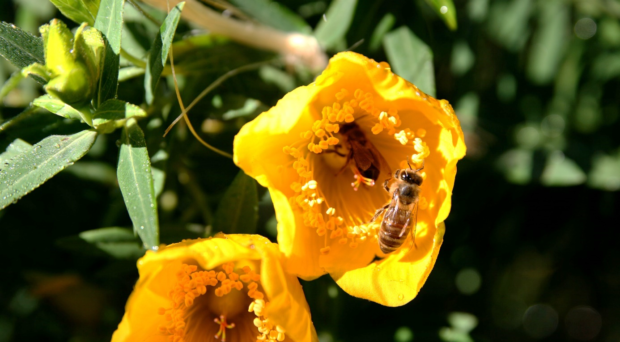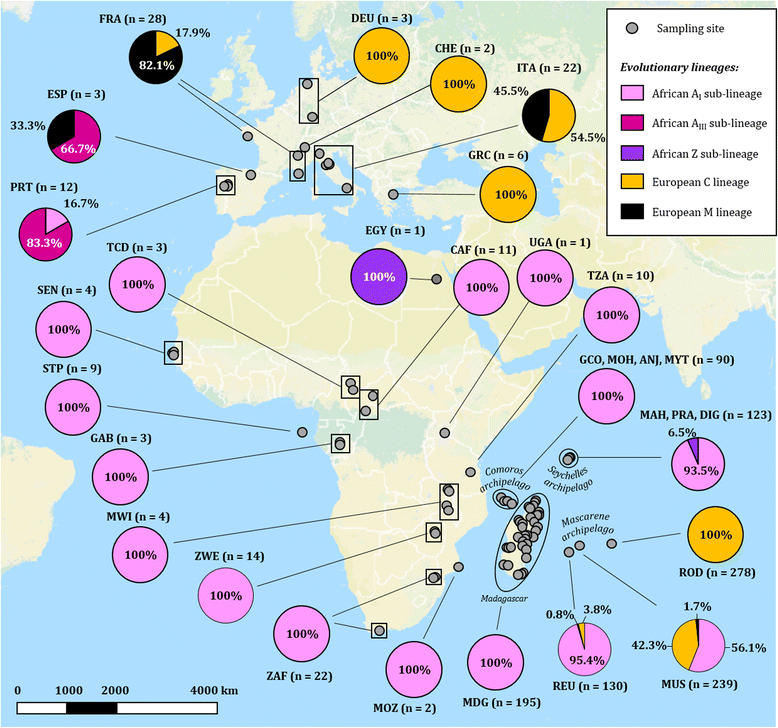
The western honeybee Apis mellifera is probably one of the most famous pollinators and has a key role in the terrestrial ecosystem. Humans have domesticated honeybees for perhaps more than 9000 years, but wild populations still exist. As beekeeping became more global, honeybees were moved out their native area and are now nearly cosmopolitan. Their wide geographic distribution shows that honeybees have the ability to adapt to very different new environments.
Originally, Apis mellifera was distributed only in Europe, Africa, the Middle East, and some parts of Asia. The exact point of origin of the western honeybee is still hard to identify, but over the last decades, five major evolutionary groups have been defined. The evolutionary complexity does not stop there, as honeybees have evolved no less than 31 recognized subspecies that can readily hybridize. The most famous example to date is the Africanized honeybee, the result of admixture between the divergent African and European lineages.

Given its intimate relationship with human movements, it can be rather hard to be sure about the honeybee presence in some regions. This difficulty is even more relevant for young isolated island systems in which the natural history before human arrival is often unclear or non-exhaustive. One illustration of such a case is the honeybee populations from the South West Indian Ocean islands (SWIO).
In this area, Madagascar and three archipelagos form one of the major hotspots of biodiversity with a high proportion of endemic species. In 1804, Pierre André Latreille described a honeybee subspecies Apis mellifera unicolor that is endemic to Madagascar. It is open to debate as to whether honeybees were present in the Mascarene, Seychelles and Comoros archipelagos before humans.
Concerns about its status were raised because of reported importations in the Mascarene and Seychelles archipelagos. Indeed, the influence of beekeeping was previously proven in Rodrigues (the far-eastern island of the Mascarenes) as a genetic study showed the exclusive presence of European Carnolian and Italian honeybees. However, this situation was exceptional as Seychelles honeybees were African and genetically related to A. m. unicolor from Madagascar.

Given such contrasting patterns, it seemed rather complicated to predict which lineages or subspecies were present in the rest of the SWIO islands. In our latest mitochondrial study, the ancestral genetic identity of honeybees from the Mascarene and Comoros was partly unraveled. Using one of the largest sampling efforts conducted for honeybees in African regions, we helped to retrace the maternal ancestry lineage using two markers. The genetic diversity observed was compared to potential source populations like Madagascar and 19 continental countries.
Interestingly, the results showed that SWIO honeybees mainly presented Apis mellifera unicolor sequences in 10 islands out of the 11 targeted (all except Rodrigues). Not only were the honeybees from the archipelagos more closely related to Madagascar, but they formed with it a novel African mitochondrial group. One way for these honeybees to reach these isolated islands despite the ocean barrier would have been via human importations.

New private A. m. unicolor derivated sequences found in each of the SWIO islands suggested an alternative hypothesis. This finding more likely points towards a long independent evolution among islands after colonization. It is not new that species that originated from Madagascar were able to cross the ocean barrier and colonize nearby islands. The distance between the islands could have been reduced with sea level fluctuations and/or hurricanes. As the Comoros archipelago diversity suggests, honeybees could have progressively colonized the islands, beginning with the nearest island to the mainland before moving from one neighbouring island to the next.
All these elements support the theory that honeybees could be native to the SWIO archipelagos. Still, European lineage was also retrieved in different frequencies in the Mascarene archipelago, revealing human impact. Until recently, honeybees from these islands were preserved from major worldwide pests such as Varroa destructor thanks to importation restrictions. The diversity of honeybees in the SWIO islands constitutes a unique heritage that deserves special attention.
Comments